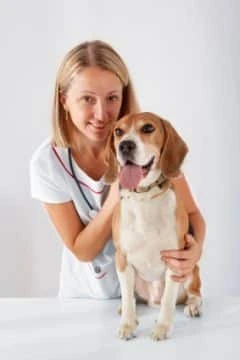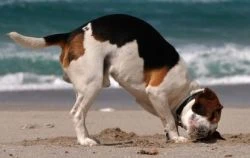Thyroid Problems in Dogs – A Guide to Hypothyroidism and Hyperthyroidism

A Guide to Thyroid Problems in Dogs…

On this page we have provided a complete guide to thyroid problems and how they affect dogs. There are actually to types of the condition including Hyperthyroidism and Hypothyroidism. However before we discuss the difference between each type we need to explain in a little more detail exactly what the thyroid gland does.
The thyroid gland has two lobes and is located near the trachea, just below the larynx in the dog’s neck. This very important gland is responsible for producing thyroid hormones including (T3) and (T4) which help to regulate a dog’s metabolic rate.
 Hypothyroidism is actually a fairly common endocrine disease that results in an underproduction of the (T3) and (T4) hormones. This basically causes your dog’s body to start slowing down causing some of the following signs and symptoms…
Hypothyroidism is actually a fairly common endocrine disease that results in an underproduction of the (T3) and (T4) hormones. This basically causes your dog’s body to start slowing down causing some of the following signs and symptoms…
1. Although some dogs will lose weight some will actually gain a few pounds.
2. A dog experiencing thyroid problems can develop scaly and dry skin.
3. Hormone diseases are associated with hair loss, so you may notice that your dog starts losing hair specifically around the top of the tail, down the chest, at the front of the neck, at the back of the thighs and on the sides of the body. The skin may also start to thicken and change pigmentation. It is also not uncommon for dogs experiencing this condition to develop skin folds that appear thicker over the face.
4. A dog experiencing thyroid problems may be unable to keep warm.
5. Tiredness and lethargy are common symptoms associated with Hypothyroidism. It is fairly common for a dog experiencing Hypothyroidism to be less alert.
6. The condition can also lead to a slow heart rate a lack of heat cycles and other health conditions including corneal ulcers, blepharitis, anemia, deafness and even constipation.
]]>
It is also worth mentioning that hypothyroidism has also been associated with other medical conditions including coronary artery disease, strokes, myasthenia gravis and von Willebrands disease. It is also estimated that at least two thirds of dogs that are experiencing the condition have high serum cholesterol levels.
How is Hypothyroidism diagnosed… Your vet may diagnose this problem by measuring the thyroid levels through blood tests. This will help determine exactly how much of the T3 and T4 hormones are being produced and circulated through the body. If the dog has normal T4 levels then this is pretty conclusive evidence that the dog does not have any thyroid problems. If the dog being examined has low-normal or below-normal T4 levels this does not necessarily mean that the dog is hypothyroid as these findings can be found in dogs that are not experiencing Hypothyroidism.
Another diagnostic test is through a blood assay test which examines the dog’s blood for a presence of thyroglobulin antibodies (these are often found in fifty percent of dogs suffering from Hypothyroidism).
It is also worth mentioning that when diagnosing this condition the vet will be looking for thyroid antibodies that are specific antibodies found in the dog’s bloodstream that target the thyroid hormones, the protein thyroglobulin and the thyroid gland. However, although these antibodies can be beneficial in predicting risk they do not necessarily confirm a diagnosis.
How is Hypothyroidism treated…?
The most common form of treatment for Hypothyroidism involves the vet administering a synthetic version of the hormones that your dog needs. The most common hormone replacement therapy consists of the vet prescribing L-thyroxine (levothyroxine) also known as L-T4. The actual dose is based on the individual dog’s weight and will be adjusted depending on each individual dog. It is also important for the vet to test the T4 levels on a frequent basis particularly during the early stages of the treatment. It is quite common for the symptoms of Hypothyroidism such as hair loss to be reversed during the treatment. It may also be necessary for the affected dog to need T3 supplementation.
What is Hyperthyroidism…? This is the opposite condition to Hypothyroidism and occurs when your dog’s thyroid gland starts to secrete too much of the hormone thyroxine. This causes the dog’s metabolism to go into overdrive causing the following signs and symptoms…
– Loss of weight.
– Diarrhea.
– Breathing problems and shortness of breath.
– The Heart rate may speed up.
– Vomiting.
– Increased appetite.
– Your dog will start urinating more.
– The affected dog may also experience Polydipsia (increased thirst)
– The dog may become hyperactive.
– The thyroid gland may also become enlarged.
What causes Hyperthyroidism…? This condition can caused by a number of factors ranging from Cancer of the Thyroid gland which may increase the amount of T3 and T4 hormones being secreted. A Tumor may also damage the functioning of the Thyroid gland causing an increase of Thyroxine being secreted.
How is Hyperthyroidism diagnosed & treated…?
The vet will achieve diagnosis in much the same to diagnosing Hypothyroidism (i.e. through blood tests). This will be achieved by the vet measuring the T4 hormone thyroid levels and how much of the hormone your dog is producing. The treatment for the condition may involve your vet surgically removing the diseased thyroid however this can also lead to Hypothyroidism developing. Of course if there is a primary health condition causing the condition such as Cancer or a Tumor then the Tumor will need to be removed and the cancer treated. Of course if the Tumor is malignant then this can lead to a negative prognosis as the cancer may have spread.
The normal and first option will always be through the use of drugs to inhibit the amount of thyroid hormones being produced. It is important that once the treatment process has started that the affected dog’s blood count and T4 levels are tested regularly. 
Thyroid problems are thought to be more common in certain breeds including, Beagles, Great Danes, Shetland Sheepdogs, Akitas, Irish Setters, Doberman Pinschers, Rottweilers, Golden Retrievers, Cocker Spaniels (American), Labrador Retrievers, Newfoundlands, Poodles, Vizslas, Schnauzers, Boxers, English Bulldogs, Pomeranians, Chow Chows, Brittanys, Dachshunds, Afghan Hounds and German Shepherds.





